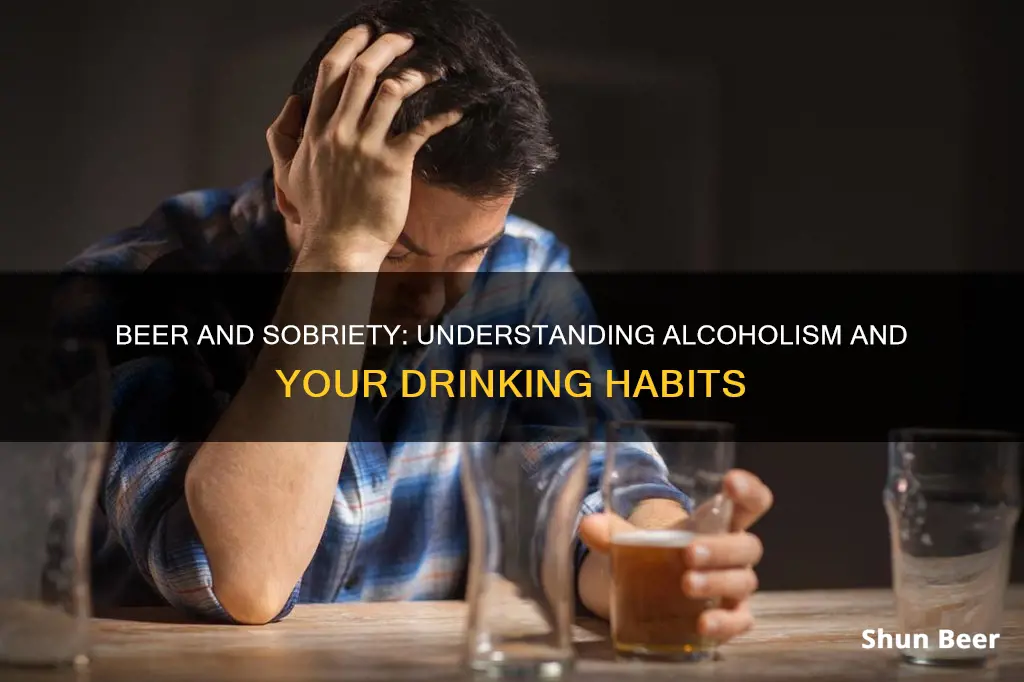
Alcoholism is a spectrum, and it's important to remember that an alcoholic doesn't always fit the stereotype of someone whose life is in turmoil. If you're worried about your drinking, there are some signs that indicate your alcohol use may have become a problem. For example, if you're drinking to relieve stress, prioritising drinking over your responsibilities, or finding that you need to drink more to feel the effects, these could be indicators that your drinking habits are becoming unhealthy. While drinking every night doesn't necessarily mean you're an alcoholic, it may be time to take a closer look at your relationship with alcohol and consider seeking help if you feel it's becoming an issue.
| Characteristics | Values |
|---|---|
| Frequency | Drinking every night |
| Amount | More than 14 units per week |
| Impact on life | Negative consequences, such as upsetting family members |
| Blackouts | Drinking to the point of not remembering the night before |
| Embarrassment | Feeling embarrassed about the amount you drink |
| Hiding drinking | Lying to or hiding your drinking from others |
| Drinking more than intended | Drinking more than you set out to in the evening |
| Stress relief | Drinking to relieve stress or relax |
| Prioritisation | Prioritising drinking over responsibilities |
| Inability to cut down | Wanting to cut down or stop drinking but being unable to |
| Cravings | Feeling a compulsion to drink or constantly craving alcohol |
| Physical addiction | Needing to drink to stave off withdrawal symptoms |
| Tolerance | Needing to drink more to feel the effects |
What You'll Learn

Alcohol dependency signs
Drinking alcohol every night does not automatically mean that someone is an alcoholic. However, it could be a sign of alcohol dependency, which is a serious issue. Alcohol dependency can be understood as a psychological or physical addiction.
Psychological Alcohol Dependency
You may have a psychological dependency on alcohol if you feel that you need a drink every night or to get through a social event, stressful situation, or personal struggle. You may also have a compulsion to drink or constantly crave alcohol, perhaps even daily. Other signs of psychological alcohol dependency include:
- Drinking to relieve stress or relax
- Prioritizing drinking over responsibilities, like family, work, and hobbies
- Wanting to cut down or stop drinking every night but being unable to
- Drinking more than you intended to in the evening
- Lying to or hiding your drinking habits from others
- Feeling embarrassed about the amount you drink
Physical Alcohol Dependency
Physical alcohol dependency occurs when a person's brain and body have adapted to having alcohol present and need it to function. Signs of physical alcohol dependency include:
- Withdrawal symptoms such as anxiety, agitation, nausea, vomiting, insomnia, nightmares, tremors, hallucinations, and seizures when you stop or reduce drinking
- Building up a tolerance to alcohol, meaning you need to drink more to feel its effects
- Physical symptoms such as indigestion, nausea, bloating, rapid eye movements, impaired attention or memory, lack of coordination, rapid heart rate, and erectile dysfunction
Seeking Help
If you think you or someone you know may be struggling with alcohol dependency, it is important to seek professional support. A healthcare provider can perform an evaluation, discuss treatment options, and provide referrals to rehab. Treatment options may include detoxification, addiction treatment programs, day care treatment programs, and outpatient treatment.
Beer and Pepcid: Safe Mix or Health Risk?
You may want to see also

Health risks of drinking
Drinking alcohol every night may be a cause for concern. While occasional beer or wine with dinner or a drink in the evening is not necessarily a health problem for most people, drinking alcohol daily may indicate a progression in your consumption and place you at increased health risks.
According to the National Institute on Alcohol Abuse and Alcoholism, drinking is considered to be in the moderate or low-risk range for women at no more than three drinks in any one day and no more than seven drinks per week. For men, it is no more than four drinks a day and no more than 14 drinks per week. Drinking more than these amounts is considered "heavy" or "at-risk" drinking, which puts you at a higher risk of developing health problems.
- Organ damage: Alcohol can damage multiple organs in the body, including the heart, liver, and pancreas. Heavy drinking can lead to liver inflammation (alcoholic hepatitis) and, in some cases, scarring of the liver (cirrhosis), which can be life-threatening. Alcohol can also cause the pancreas to produce toxic substances, leading to pancreatitis, a dangerous inflammation that causes swelling, pain, and impaired enzyme and hormone production.
- Cardiovascular issues: Drinking alcohol can negatively impact your heart health. It can lead to cardiomyopathy, which is the stretching and drooping of the heart muscle. It can also cause arrhythmias, or irregular heartbeats, and high blood pressure.
- Cancer: Alcohol consumption is linked to an increased risk of several types of cancer, including head and neck cancer, oral cavity cancer, pharynx cancer, larynx cancer, esophageal cancer, and breast cancer. Even moderate drinking can increase the risk of certain cancers.
- Immune system weakness: Chronic heavy drinking can weaken the immune system, making individuals more susceptible to diseases such as pneumonia and tuberculosis. Drinking a lot on a single occasion can also slow down the body's ability to ward off infections, even up to 24 hours after getting drunk.
- Nervous system damage: Regularly drinking excessive amounts of alcohol can damage the nervous system, leading to issues with mood, behaviour, clear thinking, and coordination.
- Mental health: There is evidence that regular drinking at high-risk levels can negatively impact mental health and increase the risk of self-harm and suicide.
- Stroke: Excessive alcohol consumption is linked to an increased risk of stroke.
- Social and behavioural issues: Drinking alcohol can increase the risk of accidents, misjudging risky situations, and losing self-control, which may lead to risky behaviours such as unprotected sex or violence.
Beer Drinking in Yellowstone: What's Allowed?
You may want to see also

Alcohol serving sizes
Drinking every night does not necessarily make someone an alcoholic, but it could be a sign of alcohol dependence or "problem drinking". If drinking is starting to impact your life, it may be time to examine your drinking habits more closely.
Signs of alcoholism or problem drinking include:
- Drinking to the point of blacking out and not remembering the night before
- Feeling embarrassed about the amount you drink
- Needing a drink before going out
- Lying or hiding your drinking from others
- Drinking more than you intended
- Drinking to relieve stress or relax
- Prioritising drinking over responsibilities
- Wanting to cut down or stop drinking but being unable to
- Building up a tolerance to alcohol
- Experiencing withdrawal symptoms if you stop drinking
Now, onto alcohol serving sizes.
It is important to remember that the amount of liquid in your glass may not match up with the amount of alcohol it contains. A "standard drink" or "alcoholic drink equivalent" is defined as any beverage containing 0.6 fluid ounces or 14 grams of pure alcohol. Here are some examples of what constitutes one standard drink:
- 12 fl oz of regular beer (usually about 5% alcohol)
- 8-10 fl oz of malt liquor or flavoured malt beverages, such as hard seltzer
- 5 fl oz of table wine (usually about 12% alcohol)
- 3-4 fl oz of fortified wine, such as sherry or port
- 2-3 fl oz of cordial, liqueur, or aperitif
- 1.5 fl oz of brandy or cognac (a single jigger)
- 1.5 fl oz shot of distilled spirits (gin, rum, tequila, vodka, whiskey, etc.)
There are weekly "upper limits" for healthy adults:
- Men: No more than four drinks in one day or 14 per week
- Women: No more than three drinks in one day or seven per week
Drinking more than these amounts is considered "heavy" or "at-risk" drinking and puts you at a higher risk of developing health problems and alcohol use disorder.
Mixing Beer and Adderall: What You Need to Know
You may want to see also

Alcohol tolerance
Physiology of Alcohol Tolerance
Direct alcohol tolerance is largely dependent on body size. Larger-bodied people will require more alcohol to reach insobriety than lightly built people. Alcohol tolerance is also connected with the activity of alcohol dehydrogenases (a group of enzymes responsible for breaking down alcohol) in the liver and in the bloodstream.
Tolerance and withdrawal are two symptoms of an Alcohol Use Disorder. If you're building your tolerance, you're moving toward physical addiction. People with high tolerance to alcohol, who do not feel the effects of alcohol after consuming several alcoholic beverages, are at a higher risk for alcohol-related problems.
Signs of Alcoholism
- Experiencing more and more negative consequences as a result of your drinking, such as upsetting your family, or feeling increasingly guilty or ashamed.
- Drinking to the point where you 'black out' and can't remember the night before, including conversations or behaviours.
- Feeling embarrassed about the amount you drink.
- Needing a drink before you go out in case there isn't enough.
- Lying to others or hiding your drinking from others.
- Drinking more than you intended on doing in the evening.
- Finding that you're drinking to relieve stress or to relax.
- Prioritising your drinking above your responsibilities, like family, work and hobbies.
- Wanting to cut down or stop drinking every night but being unable to.
Drinking more than the recommended limits puts you in the category of "at-risk" drinking. That means you have a higher risk of negative consequences related to your alcohol use, including health and social problems. You are also at higher risk of becoming addicted to alcohol. Alcohol can damage your body's organs and lead to various health concerns, including heart, liver and nerve damage, as well as memory problems and sexual dysfunction.
Beer and Metro North: What's Allowed?
You may want to see also

Alcohol addiction treatment
Drinking a beer every night does not necessarily make you an alcoholic, but it could be a sign of alcohol dependence. If you are worried about your drinking habits, it is important to look out for certain signs that indicate problem drinking or alcoholism. These signs include drinking to the point of blacking out and not being able to remember the previous night, feeling ashamed about your drinking, lying about or hiding your drinking, and prioritising drinking over your responsibilities. If you are experiencing any of these issues, it may be time to consider seeking help for alcohol addiction.
Alcohol addiction, or Alcohol Use Disorder (AUD), is a common problem, with millions of adults in the United States struggling with this disorder. The good news is that there are many effective treatment options available. The first step to getting help is usually talking to a primary care provider, who can help craft a treatment plan, evaluate overall health, and refer you to a specialist if needed. There are also free and confidential helplines, such as SAMHSA's National Helpline, which offer treatment referrals and information.
There are several types of alcohol addiction treatment, including behavioural treatments, medications, and mutual-support groups. Behavioural treatments involve working with a healthcare provider to identify and change the behaviours that lead to alcohol problems. This can include developing skills to stop or reduce drinking, building a strong support system, and learning to cope with triggers. Medications can also help reduce the urge to drink or prevent a return to drinking. Naltrexone, Acamprosate, and Disulfiram are some of the medications approved for AUD in the United States. Mutual-support groups, such as Alcoholics Anonymous (AA), provide peer support for those quitting or cutting back on their drinking. These groups can offer valuable added support when combined with treatment led by healthcare providers.
In addition to the above, there are different settings for alcohol addiction treatment, including outpatient, intensive outpatient or partial hospitalization, residential, and intensive inpatient. Outpatient treatment involves regular office, virtual, or telehealth visits for counselling, medication support, or both. Intensive outpatient or partial hospitalization provides coordinated outpatient care for complex needs. Residential programs offer a low- or high-intensity program in a 24-hour treatment setting, providing time and space away from everyday life to focus on recovery. Intensive inpatient treatment involves medically directed 24-hour services and may be necessary for managing withdrawal symptoms.
It is important to remember that there is no one-size-fits-all solution to alcohol addiction treatment. What works for one person may not work for another. The key is to seek help and remain engaged in the treatment process. With persistence and the right support, recovery from alcohol addiction is possible.
Denver's Beer Laws: Drinking in Public Parks
You may want to see also
Frequently asked questions
Drinking every night can be a sign of problem drinking or alcoholism. If you feel that you need a drink every night, experience cravings or a compulsion to drink, and are prioritising drinking over your responsibilities, then this could be a sign of alcohol dependency.
Moderate drinking is defined as one drink or less per day for women, and two drinks or less per day for men. This is based on standard drink sizes, which are: a 1.5 oz shot of about 40% alcohol, a 12 oz beer with 5% alcohol, or a 5 oz glass of wine with 12% alcohol.
Some signs of alcoholism include: drinking to cope with stress or negative emotions, experiencing cravings during the day when it is not socially acceptable to drink, and gradually consuming more alcohol to achieve the same effects.
Drinking beer every night can carry many risks, including health problems such as liver disease, heart disease, and an increased risk of certain cancers. It can also lead to alcohol use disorder and social problems.







